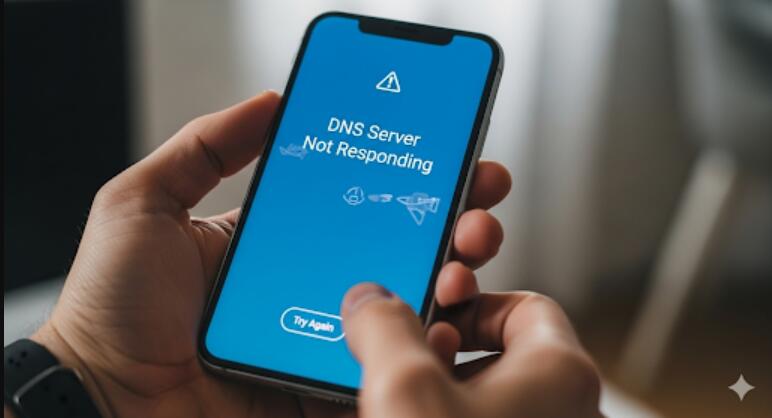How do you fix DNS server not responding on your phone?
Last updated 2025-08-28
Welcome to Blackview (Well-known brand of military grade cell phones) blog. Hope the guide helps.
The Domain Name System (DNS) acts like a digital phonebook for the internet, translating human-friendly names into machine-readable addresses. When you type a web address (like "google.com"), DNS quickly translates it into the numerical IP address that your phone or computer can understand and connect to. A non-responsive DNS server disrupts this critical translation process, effectively hindering your internet access and causing frustration. So, how exactly do you fix it when you meet this issue? Don’t worry—here is a simple, step-by-step guide to help you resolve DNS problems efficiently.

Before Start
Before diving into solutions, let's confirm it's a DNS issue and not a broader internet connectivity problem:
- Try Opening a Different Website: If other websites fail to load as well, it might be a general internet connectivity issue. Check your Wi-Fi or mobile data connection and try restarting your phone.
- Connect to a Different Network: Try connecting to a different Wi-Fi network (if available) or switch to mobile data. If the internet works on a different network, the issue might lie with the original Wi-Fi network's DNS settings (which you cannot typically control).
Common Causes of the Error:
Temporary glitches: Minor hiccups in your phone's software or network connection can disrupt DNS communication.
Incorrect DNS settings: Incorrect DNS settings on a phone prevent it from translating domain names into IP addresses, causing websites and apps to fail to load. Misconfigured entries disrupt connectivity and trigger “DNS server not responding” errors.
Cached DNS Data Corruption: Phones store DNS cache to speed up future requests. If this cache becomes corrupted, it may return incorrect or outdated IP addresses. Clearing the DNS cache (or restarting the device) often resolves this.
Router or ISP issues: Problems with your home Wi-Fi router or internet service provider (ISP) can affect DNS functionality.
VPN or Proxy Interference: VPNs and proxy servers sometimes override default DNS settings, leading to conflicts. Disabling these services or adjusting their DNS configurations can fix the issue.
Firewall or Security Software Blocking DNS: Overly aggressive firewalls or security apps may block DNS requests, mistaking them for malicious traffic. Temporarily disabling such software can help identify the cause.
Overloaded or outdated DNS servers: The DNS server you're trying to use might be experiencing high traffic or outdated information.
Read also,
Fixing Solutions
1. Restart Your Phone:
A simple restart can often resolve temporary glitches that might be causing the DNS issue. Power down your phone completely, wait for a few seconds, and then turn it back on.
2. Double-Check Your Wi-Fi or Mobile Data Connection:
A weak or unstable internet connection can cause DNS issues. Here's how to check:
- Wi-Fi: Ensure you're connected to a strong Wi-Fi network. Try moving closer to the router or restarting your router (turn it off for 30 seconds, then back on).
- Mobile Data: If you're using mobile data, ensure you have a good signal. Consider switching to Wi-Fi if available for a more stable connection. Extending reading: What cause a poor cell phone reception in house?
3. Forget and Reconnect to Wi-Fi Network:
This can refresh the DNS connection for the specific Wi-Fi network:
- Android: Go to Settings > Wi-Fi. Tap and hold on the problematic Wi-Fi network and select "Forget network." Then, re-enter the Wi-Fi password and connect again.
- iPhone: Go to Settings > Wi-Fi. Tap on the "i" icon next to the problematic Wi-Fi network. Select "Forget This Network" and confirm. Then, re-enter the Wi-Fi password and connect again.
Related,
4. Clear Your Phone's Cache:
Built-up cache can sometimes lead to connectivity issues. Clearing your phone's cache can help.
The method for clearing cache varies depending on your phone model. Consult your device's user manual for specific instructions. Here is the general guide to clear cache on your phone.
5. Disable Temporarily Antivirus or Firewall Apps:
In rare cases, overly aggressive antivirus or firewall apps might interfere with DNS requests. Try temporarily disabling them to see if it resolves the issue (remember to re-enable them for security afterward).
Extending reading,
6. Update Your Phone's Software:
Outdated phone software might have bugs that affect internet connectivity. Updating your phone's software can resolve these issues.
- Android: Open Settings > System (or About Phone) > System update. Download and install any available updates.
- iPhone: Open Settings > General > Software Update. Download and install any available updates.
7. Change Your DNS Server:
Your phone typically uses the DNS server provided by your internet service provider (ISP). If that server is overloaded or experiencing issues, you can try changing it to a public DNS server like Google Public DNS or OpenDNS.
Here's how to change your DNS server (specific steps might vary depending on your phone model):
Android:
- Open Settings and navigate to "Wi-Fi" or "Network & internet."
- Tap on the Wi-Fi network you're connected to (hold down the network name for extended options on some devices).
- Look for "Advanced options," "Modify network," or similar phrasing (terminology might vary).
- Find the option to change DNS settings. It might be labeled "IP settings," "DNS settings," or similar.
- Choose "Static" from the IP settings menu.
- Enter the preferred and alternative DNS server addresses for Google Public DNS (preferred: 8.8.8.8, alternate: 8.8.4.4) or OpenDNS (preferred: 208.67.222.222, alternate: 208.67.220.220).
- Save the changes.
iPhone:
- Open Settings and navigate to "Wi-Fi."
- Tap on the "i" icon next to the Wi-Fi network you're connected to.
- Scroll down and tap on "Configure DNS."
- Choose "Manual" from the DNS options.
- Tap the "+" sign and enter the preferred and alternative DNS server addresses for Google Public DNS (preferred: 8.8.8.8, alternate: 8.8.4.4) or OpenDNS (preferred: 208.67.222.222, alternate: 208.67.220.220). Save the changes.
8. Reset Network Settings (Android/iPhone - Last Resort):
This resets all network settings, including Wi-Fi passwords and Bluetooth connections, to factory defaults - All related accounts and passwords will be removed. Use this option cautiously:
- Android: Go to Settings > System (or General) > Reset options (or Reset). Choose "Reset Wi-Fi, mobile data & Bluetooth." You might be prompted to enter your PIN or password.
- iPhone: Go to Settings > General > Reset. Choose "Reset Network Settings." You might be prompted to enter your passcode.
Additional Tips:
- Disable VPN (if you use one): A VPN can sometimes interfere with DNS resolution. Try temporarily disabling your VPN to see if it resolves the issue.
- Check Router Settings (if applicable): If you have access to your router's settings, check out if there are any incorrect configurations.
After performing these steps, try accessing websites again. If the issue persists, consider contacting your internet service provider (ISP) for further assistance.






